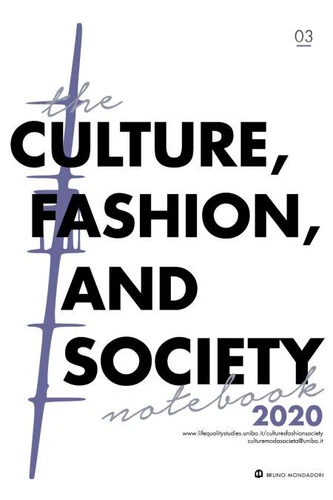From the Bronx to the Boutiques: The Rise of Street Style in the Fashion Industry
Par :Formats :
Disponible dans votre compte client Decitre ou Furet du Nord dès validation de votre commande. Le format PDF est :
- Compatible avec une lecture sur My Vivlio (smartphone, tablette, ordinateur)
- Compatible avec une lecture sur liseuses Vivlio
- Pour les liseuses autres que Vivlio, vous devez utiliser le logiciel Adobe Digital Edition. Non compatible avec la lecture sur les liseuses Kindle, Remarkable et Sony
 , qui est-ce ?
, qui est-ce ?Notre partenaire de plateforme de lecture numérique où vous retrouverez l'ensemble de vos ebooks gratuitement
Pour en savoir plus sur nos ebooks, consultez notre aide en ligne ici
- FormatPDF
- ISBN978-88-6774-248-6
- EAN9788867742486
- Date de parution11/01/2021
- Protection num.Digital Watermarking
- Taille292 Ko
- Infos supplémentairespdf
- ÉditeurBruno Mondadori
Résumé
Street style was born as the distinctive brand of the first crews in the disadvantaged Bronx in the mid-Seventies. Today this stylistic trend has established itself as a global phenomenon, and not only strictly in relation to clothing. In the more recent years of its explosive rise in the contemporary fashion industry, this trend would seem to have sacrificed its initial freshness on the altar of worldwide business.
What appears most interesting, however, is the fact that this change has allowed the 'style of the streets' to contaminate the fashion sector, even reaching into apparently untouchable sectors in the universe of the most celebrated brands. Virgil Abloh for Louis Vuitton, Alessandro Michele for Gucci, Dao-Yi Chow in Sergio Tacchini or Riccardo Tisci in Burberry (after his experience in Givenchy), Kim Jones in Dior and Raf Simons now in Calvin Klein are, in fact, only the most emblematic names in what amounts, tout-court, to a contamination which is modifying from the inside the classic canons of fashion creations.
How did this change come about? In what measure did the concept of 'new accessible luxury' dictate the extremely fast pace of this escalation? What are the consequences today, and what will they be tomorrow, of this epochal change for the fashion industry? Starting from a necessary historical excursus on the origins of this style and on its evolution over the decades, this article intends to address these questions utilizing a semiotics-based methodology.
What appears most interesting, however, is the fact that this change has allowed the 'style of the streets' to contaminate the fashion sector, even reaching into apparently untouchable sectors in the universe of the most celebrated brands. Virgil Abloh for Louis Vuitton, Alessandro Michele for Gucci, Dao-Yi Chow in Sergio Tacchini or Riccardo Tisci in Burberry (after his experience in Givenchy), Kim Jones in Dior and Raf Simons now in Calvin Klein are, in fact, only the most emblematic names in what amounts, tout-court, to a contamination which is modifying from the inside the classic canons of fashion creations.
How did this change come about? In what measure did the concept of 'new accessible luxury' dictate the extremely fast pace of this escalation? What are the consequences today, and what will they be tomorrow, of this epochal change for the fashion industry? Starting from a necessary historical excursus on the origins of this style and on its evolution over the decades, this article intends to address these questions utilizing a semiotics-based methodology.
Street style was born as the distinctive brand of the first crews in the disadvantaged Bronx in the mid-Seventies. Today this stylistic trend has established itself as a global phenomenon, and not only strictly in relation to clothing. In the more recent years of its explosive rise in the contemporary fashion industry, this trend would seem to have sacrificed its initial freshness on the altar of worldwide business.
What appears most interesting, however, is the fact that this change has allowed the 'style of the streets' to contaminate the fashion sector, even reaching into apparently untouchable sectors in the universe of the most celebrated brands. Virgil Abloh for Louis Vuitton, Alessandro Michele for Gucci, Dao-Yi Chow in Sergio Tacchini or Riccardo Tisci in Burberry (after his experience in Givenchy), Kim Jones in Dior and Raf Simons now in Calvin Klein are, in fact, only the most emblematic names in what amounts, tout-court, to a contamination which is modifying from the inside the classic canons of fashion creations.
How did this change come about? In what measure did the concept of 'new accessible luxury' dictate the extremely fast pace of this escalation? What are the consequences today, and what will they be tomorrow, of this epochal change for the fashion industry? Starting from a necessary historical excursus on the origins of this style and on its evolution over the decades, this article intends to address these questions utilizing a semiotics-based methodology.
What appears most interesting, however, is the fact that this change has allowed the 'style of the streets' to contaminate the fashion sector, even reaching into apparently untouchable sectors in the universe of the most celebrated brands. Virgil Abloh for Louis Vuitton, Alessandro Michele for Gucci, Dao-Yi Chow in Sergio Tacchini or Riccardo Tisci in Burberry (after his experience in Givenchy), Kim Jones in Dior and Raf Simons now in Calvin Klein are, in fact, only the most emblematic names in what amounts, tout-court, to a contamination which is modifying from the inside the classic canons of fashion creations.
How did this change come about? In what measure did the concept of 'new accessible luxury' dictate the extremely fast pace of this escalation? What are the consequences today, and what will they be tomorrow, of this epochal change for the fashion industry? Starting from a necessary historical excursus on the origins of this style and on its evolution over the decades, this article intends to address these questions utilizing a semiotics-based methodology.




